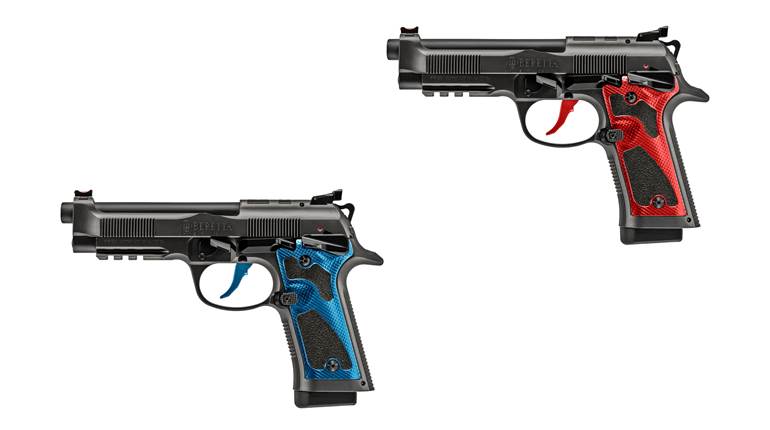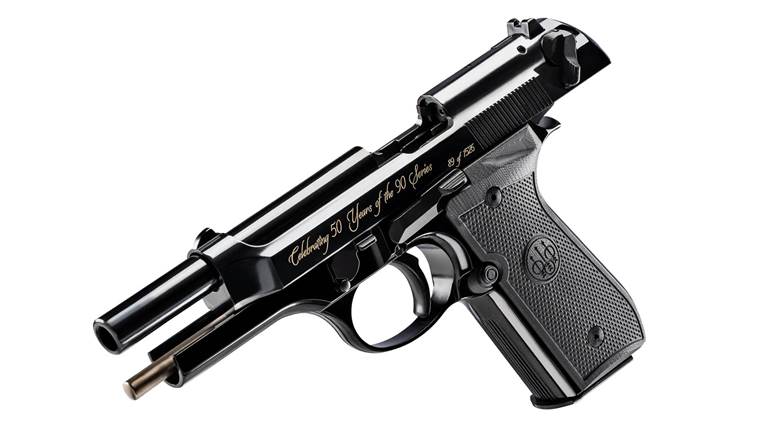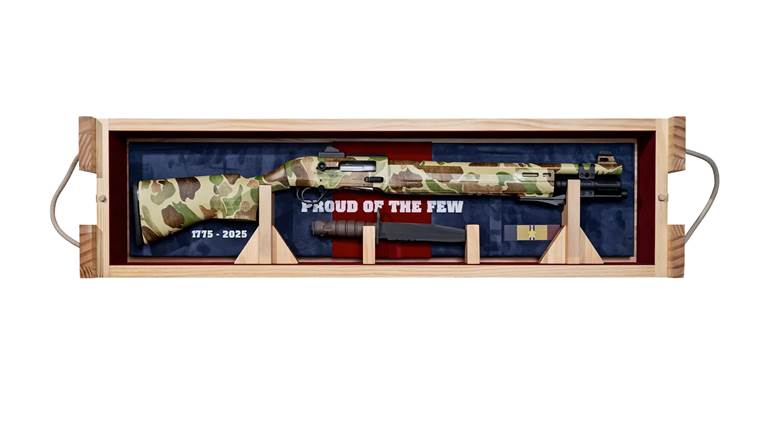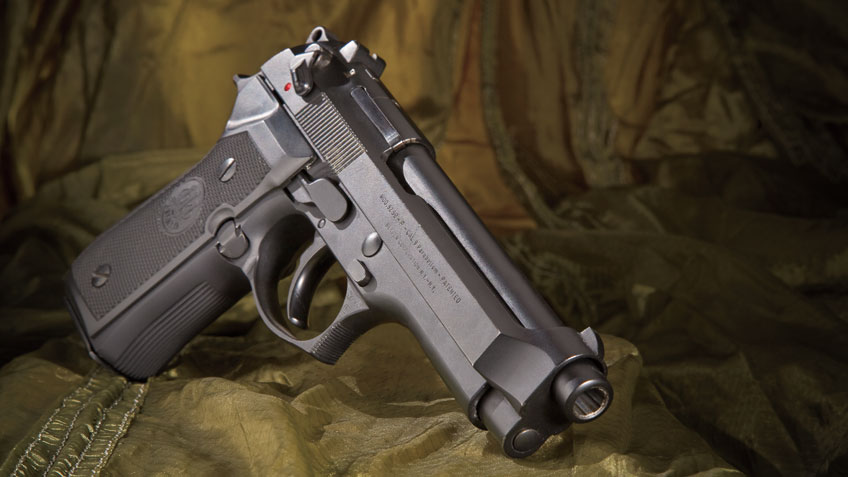
This semi-automatic pistol was part of a limited group tested in the U.S. military XM9 trials that determined the successor to the Model 1911A1. The pistol is kept on display at the National Firearms Museum in Fairfax, Va.
Prior to the adoption of the Beretta M9, a U.S. military contract truly did seem an impossible goal for a foreign company in 1978, the year Congress issued its directive to the Dept. of Defense instructing it to search for a new 9 mm handgun to replace the M1911A1.
Although the M1911 was widely recognized as a reliable, powerful and iconic sidearm of American military might, and was a favorite with veterans, soldiers and traditionalists, Congress decided that maintaining the stockpile of M1911s and some 20 other types of military sidearms was impractical. Many of the M1911s were old and in disrepair. Maintaining ammunition and parts supply for the vast array of sidearms incurred unnecessary costs. Also, Congress believed it was imperative that the U.S. adopt the standard 9 mm Luger round so its soldiers could work more closely in the field with its NATO allies.
The original Beretta 92 went through a long series of design changes during its development. In the end, the Beretta Model 92SB-F passed some of the most rigorous military firearm testing in modern history to become the “Pistol, Semiautomatic, 9 mm, M9.” In exceeding the performance of all other entries, the 92SB-F overcame political, legal and technical hurdles—in addition to harsh criticism from both military and civilian firearm enthusiasts and supporters of the M1911.

The History of the 92FS/M9
Improvements to the 92SB-F led to the Model 92FS, the lineage of which can be traced to the Model 1915, the company’s first semi-automatic pistol. Although sharing neither mechanical similarities nor outward appearances with the 92FS, the Model 1915 was the starting point from which Beretta developed its Model 1934, a major standard-issue sidearm for the Italian military during World War II. From this design the company developed the Model 1951 “Brigadier” in 9 mm Luger, which was the immediate predecessor of the original Model 92, released in 1975. It is interesting to note that, in addition, the 92FS bears significant resemblances to other manufacturers’ pre-World War II designs, most notably the Walther Model P.38.
In comparing the Walther P.38 with the Beretta 92FS, both barrels are disengaged from the slide by a locking block hinged to the underside of the barrel. Essentially, the locking block drops to a step in the frame, halting rearward movement of the barrel, keeping it horizontal with the slide during cycling and improving accuracy. Like the Walther P.38, the 92FS is chambered in 9 mm Luger, is a locked-breech double-action/single-action pistol and uses a slide-mounted safety lever. Both the 92FS and the P.38 safety levers double as de-cocking levers, releasing the hammers when rotated into the “safe” positions. Also, the 92FS safety lever acts on the exposed trigger bar like the P.38, separating the trigger mechanism from the sear for added safety. In slight contrast, however, the P.38 safety holds its firing pin in place, and the 92FS safety rotates its firing pin striker away from the hammer.
With a design heavily influenced by the P.38, the Beretta Model 1951 Brigadier was primarily a military sidearm that saw limited service in the Italian navy and police forces. It also found acceptance in a handful of African and Middle Eastern militaries. Its slide is nearly the same as that of the 92, but the gun has a cross-bolt safety on the frame and a single-stack magazine. The 92’s magazine, likely influenced by the Browning Hi-Power, is a double-stack design. The safety on the original 92 is a trigger- and slide-locking lever, located on the left side of the frame just below the slide. It can be engaged with the hammer cocked or uncocked. The Italian state police, however, preferred a de-cocking lever, so Beretta moved the safety to its current place on the slide, first seen in the Model 92S (“S” indicating a change in the safety). Although not ambidextrous, this safety feature, along with the half-cocked-hammer safety option, is nearly the same as on today’s Model 92FS.
Pistol Trials
Following its 1978 study on the stockpile of military sidearms, the House Appropriations Committee recommended to the Department of Defense that the U.S. military find a new standard pistol. The Joint Services Small Arms Program (JSSAP) was tasked with finding a 9 mm Luger, double-action pistol with at least 13-round capacity acceptable for left-handed shooters. Beretta, Colt, Smith & Wesson, Fabrique Nationale, Star, and Heckler & Koch all submitted at least one model for consideration.
Before submitting the Model 92S for testing, Beretta relocated the magazine release from the grip to the rear of the trigger guard and made it reversible for left-handed use. The safety was also made suitable for left-handed use by extending the lever to the right side of the slide. In addition, Beretta enlarged the sights and incorporated vertical grooves into the front and rear of the grip strap. The stocks had to be modified to accept the new magazine release. The company submitted this modified version, known as the 92S-1, for testing at Eglin Air Force Base in 1979. (The “1” indicated the first considerable change in the 92S design.)
After extensive tests, including those for accuracy, endurance, reliability and performance in various environmental conditions, the Air Force determined that the Model 92S-1 was superior to all other entries and recommended that it replace the M1911A1.

The Army Balks
The U.S. Army, however, disputed the results of these trials, and the implementation of the Air Force’s recommendation was postponed. The Army said that the results of the tests were skewed because of unscientific techniques and criteria, incorrect mud consistency and other issues. As a result, the Army began a new series of JSSAP pistol trials with new standards in 1981. The Army’s list of requirements was far more extensive than that of the Air Force, with requirements ranging from disassembly without tools to plastics impervious to insect repellent. By the February 1982 deadline, none of the pistols had successfully completed the testing because of the unrealistic reliability standards. Of the 72 “mandatory” and 13 “desirable” requirements, no entry met more than 11 of those standards.
In the meantime, Beretta modified the 92S-1 in 1980 and presented it to the commercial market in 1981. It became known as the Model 92SB (“B” denoting the second change to the Model 92S). The most significant change was the incorporation of a firing pin lock that prevents the firing pin from striking the cartridge primer until the trigger is pulled completely back and the hammer is entirely rearward. In case the pistol is dropped muzzle-first, the firing pin will not strike the cartridge primer. The rectangular lock moves up to allow the pin to strike, becoming exposed just in front of the rear sight during operation. Beretta also employed an overtravel stop at the top of the trigger to prevent rearward trigger movement after sear release and slightly modified the safety lever and grip designs.
When the Army released its report on the JSSAP pistol tests in 1982, the U.S. Government Accounting Office and members of Congress were displeased. The standards were unrealistic and the manufacturers were given too little time to review criteria before testing. After spending $2 million, they were no closer to finding a replacement. It was becoming apparent that the Army did not want to replace the M1911 with any other sidearm, given its response that current M1911 stockpiles were sufficient to meet military sidearm demands.

The 1983-84 Tests
In mid-1982, the secretary of defense announced there would be another series of tests with modified standards. Congress, however, postponed the new contest until the Army assured it that it would find a winner, and it withdrew funding for .45 ACP ammunition and M1911A1 parts to force compliance with the directive. Funding was to be provided after testing and recommendation of a new 9 mm pistol.
Beretta continued to make improvements to its 9 mm pistol. The new 92SB-F had a number of modifications from the 92SB. The trigger guard was squared and serrated for better two-handed control; the barrel was chrome-plated; the grip plates were allayed for easier access to the safety lever; the blued finish was replaced with a dull, black “Bruniton” enamel; grip screw slots were widened and lengthened; the bottom of the frontstrap was slightly extended for finger support; and the magazine floorplate was extended. Known in the civilian market simply as the Model 92F, the Beretta Model 92SB-F was the next pistol Beretta submitted for military testing.
In 1983, JSSAP again designated the Army as the lead controller in the new series of modified tests, known as the XM9 Service Pistol Trials (“XM” for experimental model). Eight models were submitted for testing: Beretta’s 92SB-F; Colt’s SSP; FN’s Double Action; Heckler & Koch’s P7M13; SIG Sauer’s P226; Smith & Wesson’s Model 459; Steyr’s Model GB; and Walther’s P 88. Testing began in 1984 and included standards for endurance, reliability, environmental exposure, and firing pin energy and accuracy, among others.
All pistols passed the firing pin energy tests, despite questionable results for the Smith & Wesson model, but it was allowed to continue. All but the Steyr Model GB passed the reliability test, at which point the Model GB was withdrawn from further competition.
Fabrique Nationale and Colt withdrew their firearms from consideration in mid-1984. The remaining five pistols were shipped to Aberdeen Proving Ground in Maryland and Fort Benning, Ga., for accuracy and environmental tests. The control M1911A1, despite sub-par results in previous tests, dominated the mud tests with a perfect score: After being submerged then fired wet and dry repeatedly over an extended period of time, the M1911 functioned flawlessly. The H&K, Beretta, and S&W passed with near-perfect scores, but the SIG scored only 79 percent in the dry mud phase. The Walther failed both wet and dry mud tests.
Because of shortcomings including service life, firing pin energy and environmental tests, the Army pulled the H&K, Walther and S&W from further consideration. Reportedly, those pistols had remained in the contest that long only because the Army wanted to avoid again being faced with having no clear winner. So, with only the Beretta 92SB-F and SIG P226 having passed the testing requirements, the remaining pistols could be comfortably eliminated and bidding could begin.
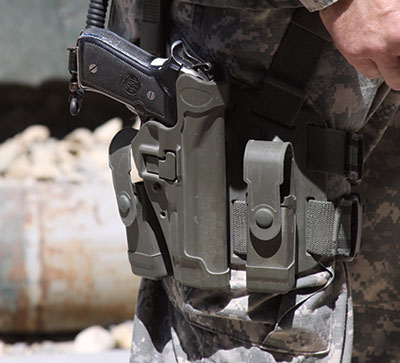
The Winning Bid
Beretta held a distinct advantage over SIG when bidding was opened: It already had a fully functioning small arms factory operating in the United States. Despite this advantage, however, SIG underbid Beretta by $9 million for the costs of providing the pistols, magazines and spare parts kits. But rather than accepting the SIG bid, the Army contacted each manufacturer and provided more information on performance and cost requirements related to the firearms and bidding. In the second round of bidding, Beretta underbid SIG by $3 million and received the contract for 315,930 Model 92SB-F pistols to be supplied to all U.S. military branches during the following five years. The Beretta Model 92SB-F was formally recognized as the M9 on Jan. 14, 1985.
The initial Beretta operation went forward despite legal challenges from H&K, SIG and S&W over the nature of the testing. H&K’s and SIG’s cases were dismissed, but S&W appealed its case in court and eventually directly petitioned the General Accounting Office. Consequently, Congress intervened and ordered that the initial Beretta contract be implemented, but that any future contracts for U.S. military service pistols remain open pending yet another pistol competition.
Although a number of firearms were briefly considered at first, the XM10 pistol trials (as they were known) included just the Beretta 92SB-F, the upgraded S&W Model 459 with chrome-lined bore and many stainless steel parts, and the Ruger P-85. SIG was unable to construct a factory in the United States, as would be required in the contract, nor could it keep costs down enough to stay competitive. Therefore, the company did not submit its pistol. With the same standards for testing as set out in the XM9 trials, the XM10 pistol trials resulted in the Beretta 92SB-F predictably winning the competition again. Beretta was awarded another contract for 57,000 pistols in May 1989, solidifying its place as the official U.S. military sidearm.

Further Improvements
Despite nearly 15 years of testing and modifications, however, the Model 92 still exhibited apparent flaws. Between 1984 and 1988, there were at least three instances of slide breakages with an M9 or Model 92SB during military training, although these were isolated incidents in which the shooter fired from between 4,500 to 30,000 rounds before slide failure. After issuing shot limits on the slides, the Army performed focused laboratory tests. In a seven-month period in 1988, the Army broke at least 11 slides after shooting from 4,900 to 30,500 rounds through each pistol in a controlled environment. The thin areas of the slides by the locking-block recesses simply snapped, and the rear portion separated from the frames.
Beretta initiated its own testing in 1989 with very different results: After firing 12 pistols at least 20,000 times each, there were no slide breakages. Beretta concluded that the reason behind the slide failures was the U.S. military’s use of overly powerful M882 and other ammunition that exceeded NATO standards. It was not a metallurgical weakness, Beretta concluded, but dangerously over-pressure ammunition that was causing the breakages.
In response to the slide failures and after the XM10 trials, the Army insisted that Beretta retrofit existing M9s with a “slide retention device” and begin installing them in all future pistols. The “device” is simply an enlarged portion of the hammer axis pin that protrudes from under the grip panel. A corresponding slot on the underside of the slide engages the pin in case of a slide failure, preventing the rear piece of the slide from flying off the frame.
Also, the U.S. Army changed the propellant mix of the M882 ammunition to one slightly less powerful to help prevent any future slide failures. The new pistol was still the M9, but those Model 92SB-F pistols in the commercial market, also known as Model 92F, were redesignated Model 92FS (“S” denoting the addition of the slide retention device).
The latest improvement to the M9 design came with the M9A1, which the Marine Corps ordered in 2006. Beretta added a Picatinny rail to the dust cover to accommodate accessories, further pronounced the grips on the frontstrap and backstrap, and thickened the front of the trigger guard. Also, it used a “Physical Vapor Deposition” process to coat the magazines and added a vertical groove to the magazine body to release sand.
The M9 Today
Nearly 25 years after its adoption, the Beretta M9 is the primary sidearm for all U.S. military branches except the Coast Guard, which recently switched to a SIG model. The M9 has proven itself a reliable and accurate sidearm in all of the combat theaters in which it has been used. It has a long sight radius, comfortable grip and optimal ergonomics, and its breakdown for cleaning and maintenance is fast and easy. It is, however, a comparatively heavy and bulky 9 mm sidearm, and some claim its open-slide design allows significant dust and dirt ingress that is less than desirable in desert warfare. Others claim quite the opposite: The open-slide design allows dirt to escape from the barrel/slide assembly. Either way, the M9’s performance in Iraq and Afghanistan has been commendable. The only mechanical shortcoming in the system was the use of sub-par magazines the U.S. government ordered from Check-Mate Industries before the war. Reportedly, the specifications the government requested resulted in magazines that performed poorly in desert climates. Many soldiers brought Beretta magazines with them to ensure reliability. Fortunately, the military recognized this shortcoming and ordered at least 2 million magazines made to proper specifications, and with positive results.
Most recently the U.S. government issued a new contract for the procurement of up to 450,000 more M9 pistols, the largest military handgun contract since World War II. The M9 has distinguished itself time and again at the proving grounds, in the field and in war, and with this latest contract it appears the M9 will remain the U.S. military sidearm for the foreseeable future.
It is hard to imagine how gunsmith Bartolomeo Beretta would have reacted in 1526 to the idea that his descendants would win the most prestigious military sidearm contract for the most powerful military in the modern world. He surely would have been proud. Perhaps, too, he would have agreed with the idea that a good soldier needs a good sidearm, and a good gunmaker can be that soldier’s best friend when that sidearm is truly needed.












